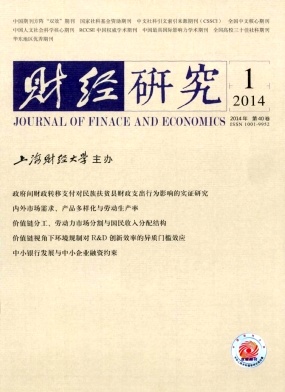中国中小型民营企业的被迫国际化——以制度环境与创新能力影响下的共生性依赖为视角
财经研究 2014 年 第 40 卷第 01 期, 页码:85 - 94
摘要
参考文献
摘要
以往国际化理论致力于探究企业进行国际化的动因并将企业国际化看成是一种主动行为。然而,忽视制度背景的国际化理论显然对中国中小型民营企业的国际化现象解释乏力。基于此,文章构建了共生性依赖与国际化的关系模型,并运用第九次全国私营企业调查数据进行实证分析。研究发现,中小型民营企业对商业生态系统的依赖程度越强,则越倾向于选择国际化战略以降低这种依赖程度;当所在区域市场化程度较高时,企业有机会选择其他适应性战略来降低对外界的依赖程度,其国际化迫切性反而减弱;随着企业创新技术能力水平的提升,企业更有能力降低对商业生态系统的依赖程度,也更有动力进行国际化。文章呈现了更符合中国实际情况的中小型民营企业国际化路径,针对现有理论提出了有力的竞争性分析框架—"被迫国际化"。
[1]曹洪军,赵翔,黄少坚.企业自主创新能力评价体系研究[J].中国工业经济,2009,(9):105-114.
[2]陈晓鹏.我国中小企业的困境、成因与出路[J].企业改革与管理,2012,(1):19-22.
[3]陈志武.中国人为何勤劳而不富有[M].北京:中信出版社出版,2010.
[4]樊纲,王小鲁,朱恒鹏.中国市场化指数—各地区市场化相对进程2009年度报告[M].北京:经济科学出版社,2010.
[5]莱维恩,扬西蒂.共赢:商业生态系统对企业战略、创新和可持续性的影响[M].(王凤彬等译)北京:商务印书馆出版社,2006.
[6]李子杰,李毅,刘畅.制度环境与合资企业战略突变:基于788家中小中外合资企业的实证研究[J].管理世界,2011,(10):84-93.
[7]林毅夫,李志赟.政策性负担、道德风险与预算软约束[J].经济研究,2004,(2):17-27.
[8]潘红波,余明桂.支持之手、掠夺之手与异地并购[J].经济研究,2011,(9):108-120.
[9]Audia P G F.Organizational foundings in community context:Instruments manufacturers and their interrelationship with other organizations[J].Administrative Science Quarterly,2006,51(3):381-419.
[10]Baker T,Nelson R E.Creating something from nothing:Resource construction through entrepreneurial bricolage[J].Administrative Science Quarterly,2005,50(3):329-366.
[11]Bruton G D,Dess G G,Janney J J.Knowledge management in technology-focused firms in emerging economies:Caveats on capabilities,networks,and real options[J].Asia Pacific Journal of Management,2007,24(2):115-130.
[12]Carroll G R,Khessina O M.The ecology of entrepreneurship[A].Alvarez S A,Agarwal R,Sorenson O(eds.),Handbook of Entrepreneurship Research:Disciplinary Perspectives[C].New York:Springer.,2005:167-200.
[13]Child J,Chung L,Davies H.The performance of cross-border units in China:A test of natural selection,strategic choice and contingency theories[J].Journal of International Business Studies,2003,34(3):242-254.
[14]Daphne W Y.Outward foreign direct investment by emerging market firms:resource dependence logic[R].Working Paper.2013.
[15]Gulati R,Sytch M.Dependence asymmetry and joint dependence in interorganizational relationships:Effects of embeddedness on a manufacturer’s performance in procurement relationships[J].Administrative Science Quarterly,2007,52(1):32-69.
[16]Hawley A H.Human ecology:A theory of community structure[M].New York:Ronald Press Co.,1950.
[17]Hitt M A,Bierman L,Uhlenbruck K,et al.The importance of resources in the internationalization of professional service firms:The good,the bad,and the ugly[J].Academy of Management Journal,2006,49(6):1137-1157.
[18]Hitt M A,Boyd B K,Li D.The state of strategic management research and a vision of the future[J].Research Methodology in Strategy and Management.2004,1(4):1-31.
[19]Johanson J,Mattsson L.Internationalization in industrial systems-a network approach[J].Strategies,1988:287-314.
[20]Johansson J,Vahlne J.The mechanism of internationalization[J].International Marketing Review,1990,7(4):11-24.
[21]Knight G A,Cavusgil S T.The born global firm:A challenge to traditional internationalization theory[J].Advances of International Marketing,1996.
[22]Knight G A,Cavusgil S T.Innovation,organizational capabilities,and the born-global firm[J].Journal of International Business Studies,2004,35(2):124-141.
[23]Lu J Y,Liu X H,Wang H L.Motives for outward FDI of Chinese private firms:Firm resources,industry dynamics,and government policies[J].Management and Organization Review,2011,7(2):223-248.
[24]Meyer K E,Peng M W.Probing theoretically into Central and Eastern Europe:Transactions,resources,and institutions[J].Journal of International Business Studies,2005,36(6):600-621.
[25]Narayanan V K,Fahey L.The relevance of the institutional underpinnings of Porter’s five forces framework to emerging economies:An epistemological analysis[J].Journal of Management Studies,2005,42(1):207-223.
[26]Oviatt B M,McDougall P P.Toward a theory of international new ventures[J].Journal of International Business Studies,1994,25(1):45-64.
[27]Oviatt B M,Mcdougall P P.Defining international entrepreneurship and modeling the speed of internationalization[J].Entrepreneurship Theory and Practice,2005,29(5):537-553.
[28]Peng M W,Li Y,Xie E,et al.CEO duality,organizational slack,and firm performance in China[J].Asia Pacific Journal of Management,2010,27(4):611-624.
[29]Pfeffer J A P N.Joint ventures and interorganizational interdependence[J].Administrative Science Quarterly.1976,21(3):398-418.
[30]Pfeffer J,Salancik R G.The external control of organizations:A resource dependence perspective[M].Stanford University Press,2003.
[31]Priem R L,Butler J E.Is the resource-based“view”a useful perspective for strategic management research?[J].Academy of Management Review,2001,26(1):22-40.
[32]Villanueva J,Van De Ven A H,Sapienza H J.Resource mobilization in entrepreneurial firms[J].Journal of Business Venturing,2012,27(1):19-30.
①利基(Niche)市场,指的是被占据市场绝对优势的企业所忽略的某些细分市场。
②“父爱主义”:预算软约束理论认为政府之所以支持国有企业,是因为政府与国有企业之间存在控制与被控制的关系,从而政府视国企为自己的子女,对国企存在“父爱主义”。(林毅夫、李志赟,2004;潘红波、余明桂,2011)
③限于篇幅,原模型检验结果未详细列示,如有需要可向作者索取。
[2]陈晓鹏.我国中小企业的困境、成因与出路[J].企业改革与管理,2012,(1):19-22.
[3]陈志武.中国人为何勤劳而不富有[M].北京:中信出版社出版,2010.
[4]樊纲,王小鲁,朱恒鹏.中国市场化指数—各地区市场化相对进程2009年度报告[M].北京:经济科学出版社,2010.
[5]莱维恩,扬西蒂.共赢:商业生态系统对企业战略、创新和可持续性的影响[M].(王凤彬等译)北京:商务印书馆出版社,2006.
[6]李子杰,李毅,刘畅.制度环境与合资企业战略突变:基于788家中小中外合资企业的实证研究[J].管理世界,2011,(10):84-93.
[7]林毅夫,李志赟.政策性负担、道德风险与预算软约束[J].经济研究,2004,(2):17-27.
[8]潘红波,余明桂.支持之手、掠夺之手与异地并购[J].经济研究,2011,(9):108-120.
[9]Audia P G F.Organizational foundings in community context:Instruments manufacturers and their interrelationship with other organizations[J].Administrative Science Quarterly,2006,51(3):381-419.
[10]Baker T,Nelson R E.Creating something from nothing:Resource construction through entrepreneurial bricolage[J].Administrative Science Quarterly,2005,50(3):329-366.
[11]Bruton G D,Dess G G,Janney J J.Knowledge management in technology-focused firms in emerging economies:Caveats on capabilities,networks,and real options[J].Asia Pacific Journal of Management,2007,24(2):115-130.
[12]Carroll G R,Khessina O M.The ecology of entrepreneurship[A].Alvarez S A,Agarwal R,Sorenson O(eds.),Handbook of Entrepreneurship Research:Disciplinary Perspectives[C].New York:Springer.,2005:167-200.
[13]Child J,Chung L,Davies H.The performance of cross-border units in China:A test of natural selection,strategic choice and contingency theories[J].Journal of International Business Studies,2003,34(3):242-254.
[14]Daphne W Y.Outward foreign direct investment by emerging market firms:resource dependence logic[R].Working Paper.2013.
[15]Gulati R,Sytch M.Dependence asymmetry and joint dependence in interorganizational relationships:Effects of embeddedness on a manufacturer’s performance in procurement relationships[J].Administrative Science Quarterly,2007,52(1):32-69.
[16]Hawley A H.Human ecology:A theory of community structure[M].New York:Ronald Press Co.,1950.
[17]Hitt M A,Bierman L,Uhlenbruck K,et al.The importance of resources in the internationalization of professional service firms:The good,the bad,and the ugly[J].Academy of Management Journal,2006,49(6):1137-1157.
[18]Hitt M A,Boyd B K,Li D.The state of strategic management research and a vision of the future[J].Research Methodology in Strategy and Management.2004,1(4):1-31.
[19]Johanson J,Mattsson L.Internationalization in industrial systems-a network approach[J].Strategies,1988:287-314.
[20]Johansson J,Vahlne J.The mechanism of internationalization[J].International Marketing Review,1990,7(4):11-24.
[21]Knight G A,Cavusgil S T.The born global firm:A challenge to traditional internationalization theory[J].Advances of International Marketing,1996.
[22]Knight G A,Cavusgil S T.Innovation,organizational capabilities,and the born-global firm[J].Journal of International Business Studies,2004,35(2):124-141.
[23]Lu J Y,Liu X H,Wang H L.Motives for outward FDI of Chinese private firms:Firm resources,industry dynamics,and government policies[J].Management and Organization Review,2011,7(2):223-248.
[24]Meyer K E,Peng M W.Probing theoretically into Central and Eastern Europe:Transactions,resources,and institutions[J].Journal of International Business Studies,2005,36(6):600-621.
[25]Narayanan V K,Fahey L.The relevance of the institutional underpinnings of Porter’s five forces framework to emerging economies:An epistemological analysis[J].Journal of Management Studies,2005,42(1):207-223.
[26]Oviatt B M,McDougall P P.Toward a theory of international new ventures[J].Journal of International Business Studies,1994,25(1):45-64.
[27]Oviatt B M,Mcdougall P P.Defining international entrepreneurship and modeling the speed of internationalization[J].Entrepreneurship Theory and Practice,2005,29(5):537-553.
[28]Peng M W,Li Y,Xie E,et al.CEO duality,organizational slack,and firm performance in China[J].Asia Pacific Journal of Management,2010,27(4):611-624.
[29]Pfeffer J A P N.Joint ventures and interorganizational interdependence[J].Administrative Science Quarterly.1976,21(3):398-418.
[30]Pfeffer J,Salancik R G.The external control of organizations:A resource dependence perspective[M].Stanford University Press,2003.
[31]Priem R L,Butler J E.Is the resource-based“view”a useful perspective for strategic management research?[J].Academy of Management Review,2001,26(1):22-40.
[32]Villanueva J,Van De Ven A H,Sapienza H J.Resource mobilization in entrepreneurial firms[J].Journal of Business Venturing,2012,27(1):19-30.
①利基(Niche)市场,指的是被占据市场绝对优势的企业所忽略的某些细分市场。
②“父爱主义”:预算软约束理论认为政府之所以支持国有企业,是因为政府与国有企业之间存在控制与被控制的关系,从而政府视国企为自己的子女,对国企存在“父爱主义”。(林毅夫、李志赟,2004;潘红波、余明桂,2011)
③限于篇幅,原模型检验结果未详细列示,如有需要可向作者索取。
引用本文
张瑾华, 李新春, 何轩. 中国中小型民营企业的被迫国际化——以制度环境与创新能力影响下的共生性依赖为视角[J]. 财经研究, 2014, 40(1): 85–94.
导出参考文献,格式为:





 7370
7370  4669
4669

